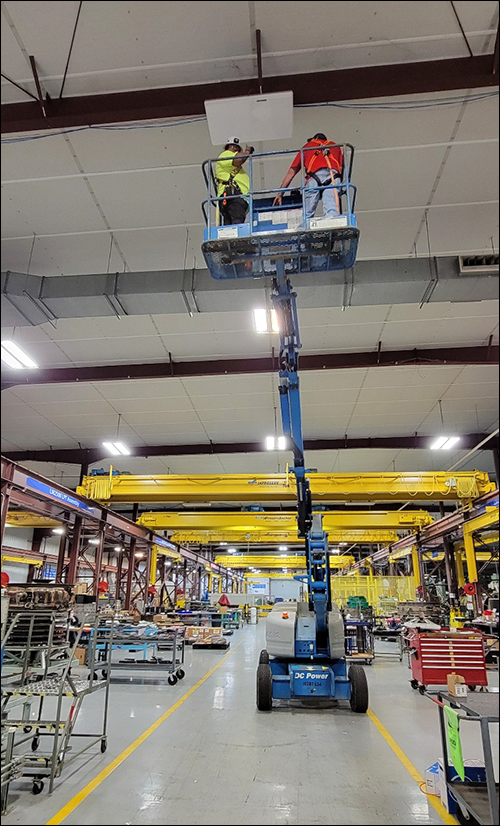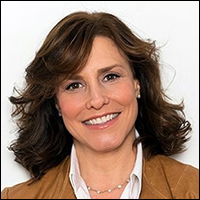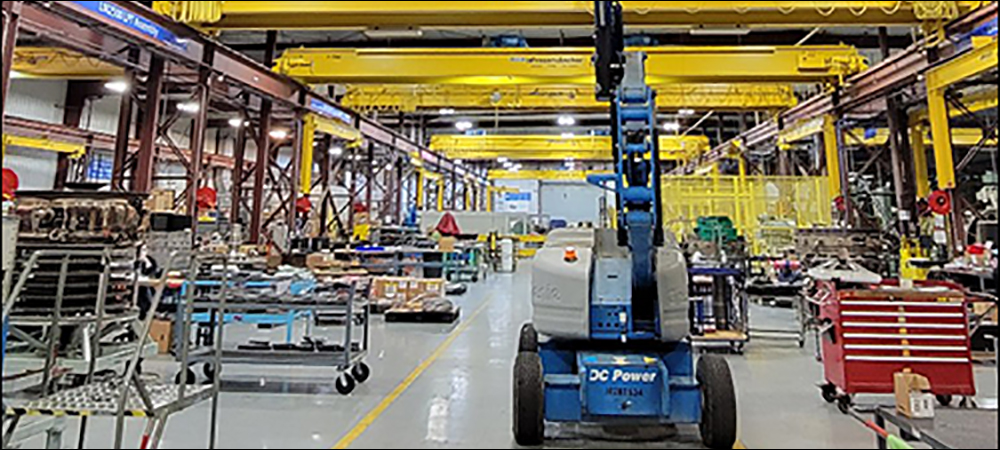- Growing Need for Real-Time Location on Factory Floors
- Integrated System to Tie Programs into One Solution
- Tracking Work-in-Progress, Locating Tools

The solution can monitor everything from returnable transport items and forklifts to tools, parts, personnel, pallets and raw materials.
Industrial Internet of Things (IIoT) solution provider Tego has partnered with RF Controls to deliver passive RFID-based, real-time track-and-trace visibility into forklifts, returnable transport items, assets, tools and individuals, as part of its smart factory solution for aerospace and defense companies. The Tego solution, leveraging RF Controls’ overhead RFID technology, was initially deployed for a large aerospace company that has asked to be unnamed, and it is now being planned for use in other factory and warehouse settings.
The full solution can capture the locations of people and things via passive UHF RFID tags as they move around a facility in real time. That data is then included in Tego’s overall software platform. Tego offers what it describes as enterprise-wide visibility, automated process traceability and reporting, with a solution that can be integrated with customers’ own software programs, such as like manufacturing execution systems (MES) and SAP. Its Asset Intelligence Platform (AIP) includes apps, cloud-based data management and IoT hardware.
The company works with a variety of technology vendors to deliver the data used in its platform, according to LaVerne Cerfolio, Tego’s marketing VP. That means businesses can leverage Tego’s management platform with a variety of technologies that can include barcodes, QR codes and RFID. However, Cerfolio says, RF Controls’ UHF RFID real-time locating system (RTLS) technology brings another tool to the solution in the form of affordable, real-time visibility. “By teaming together,” she states, “we [Tego and RF Controls] facilitate faster, out-of-the-box solution adoption and implementation among customers.”
RF Controls developed an “all-in-one” overhead steerable beam antenna and reader that can identify, locate, track and encode passive UHF RFID tags from as high as 50 feet above the floor, pinpointing those tags’ locations within 1 to 3 feet, explains Adrian Turchet, RF Controls’ COO. Its technology is already deployed by manufacturers to track parts, components and materials used in factories throughout their production facilities and as they are transformed into finished goods. Reader antennas are installed on high ceilings, where they can gain the widest coverage area and are out of the way of assembly equipment (see Tego Releases Environmental-Monitoring Technology for Pharmaceutical Applications).
Growing Need for Real-Time Location on Factory Floors
Demand for real time visibility in locations such as assembly plants has been growing, Cerfolio says, in part due to challenges caused by the COVID-19 pandemic. For one thing, she notes, there often are fewer employees available for worksites, even as customers place a greater demand on manufacturers for fast delivery of goods. Thus, businesses are striving to become more efficient. One way to do that, Cerfolio says, is with a better view into what is on the manufacturing floor.
Those already using RF Controls technology are often large, complex manufacturing sites at which there may be thousands of products and components on the floor. That can mean everything from returnable transport items and forklifts to tools, parts, personnel, pallets or raw materials. Tracking every item or person is time-consuming, and most real-time locating systems require battery-powered devices which use UWB or BLE systems that can be costly to install and maintain. “You just can’t support the maintenance cost of changing so many batteries,” Turchet says, “when thousands of tags are required.”
When using UWB or BLE tags, they are often asked to report location data through frequent transmission of that location information (ever second, for instance), which would further drain power and lead to the need for frequent battery replacements. Passive UHF RFID is the best alternative to battery maintenance issues, the companies explain, since tags require no batteries and only respond to interrogation received from a reader. Traditionally, visibility has been limited to chokepoints where RFID gates are installed, or to when a handheld reader is used. With the RF Controls partnership, Cerfolio says, “We’re unlocking this option to basically be a real-time solution using passive RFID at any ceiling height.”
Integrated System to Tie Programs into One Solution

LaVerne Cerfolio
Tego’s solution features a single user interface that interacts with other manufacturing software programs. “The benefit of that,” Cerfolio states, “is that we have one flexible interface for reporting, so we can push and pull data up and down the organization and then tie that into the automated visibility” from the RFID data. Companies may have technology to capture details about work-in-progress (WIP), she says, though it requires manual input and lacks data integration across other systems for decision making.
Tego’s software combines process flow data, manufacturing information, purchasing data, material inventory levels and other information from a warehouse-management system, Cerfolio says, then provides visibility into what is happening “through the RTLS portion of our solution.” One immediate benefit to the real-time passive RFID functionality, she adds, might be viewing WIP information about a product when customers request updates. Workers could access the software to search for a specific order, view where the item is located—in the kitting process, for instance—and update customers quickly.
Alerts related to delays or the misrouting of products on the production floor could help operators prevent errors as well. Real-time data allows companies to locate assets, such as a missing tool during an assembly step, and issue alerts if a component or tool is in a space that could result in delivery delays, such as a warehouse with a one-hour wait for deliveries. Tego’s solution is designed for use in the supply chain, such as at warehouses and distribution centers. Therefore, Cerfolio says, automated real-time visibility can help businesses understand when components will be received, and the data can be viewed and managed via Tego’s dashboards.
Tracking Work-in-Progress, Locating Tools
The aerospace company that is already using the technology from Tego and RF Controls had previously tried other real-time locating technologies with active, battery-powered sensors. It found that the cost of the sensors and their battery replacements was not feasible in large numbers. The company is now using the RF Controls system with passive, low-cost UHF RFID tags that can be affixed to a variety of assets, or be worn in badges by personnel, to provide the visibility required for efficiency and safety purposes.

Adrian Turchet
RF Controls provides one of multiple solutions using overhead readers for real-time data based on the locations of passive RFID tags (see Best New RFID Products of 2020: RF Controls’ CS-490 Smart Antenna and Times-7’s Packing Station and RTLS Reader from RF Controls Features Steerable Array Antenna). “We’re starting to see more overhead solutions on the market,” Turchet says, but he contends that the RF Controls performance capabilities are unique. While some overhead RFID antenna reader systems offer a read range of about 10 or 15 feet, the RF Controls antennas can detect tags and their locations at the distance required in manufacturing settings.
In 2020, RF Controls released its CS-490 antenna, which reads tags from a height of up to 50 feet, with a maximum read distance of up to 90 feet. The widest area of coverage from a single RF Controls antenna, Turchet says, is based on the ceiling height (the higher the ceiling, the greater the coverage area), as well as how open the space is. For example, a 30-foot ceiling-mounted antenna could provide coverage of up to 3,600 square feet. Location granularity can be between 1 and 3 feet.
Tego’s goal, according to Cerfolio, is to provide solutions based on the problem, rather than on the capabilities of specific technologies. “What we ask our customers is, ‘What problem are we trying to solve?’ and then we’ll figure out the right technology that works for that problem,” she states.
Key Takeaways:
- The technology company partnership brings real-time passive RFID data to an enterprise-based system for aerospace and defense manufacturers.
- One aerospace company has already deployed the system, while Tego is in conversations with other potential customers as well.


